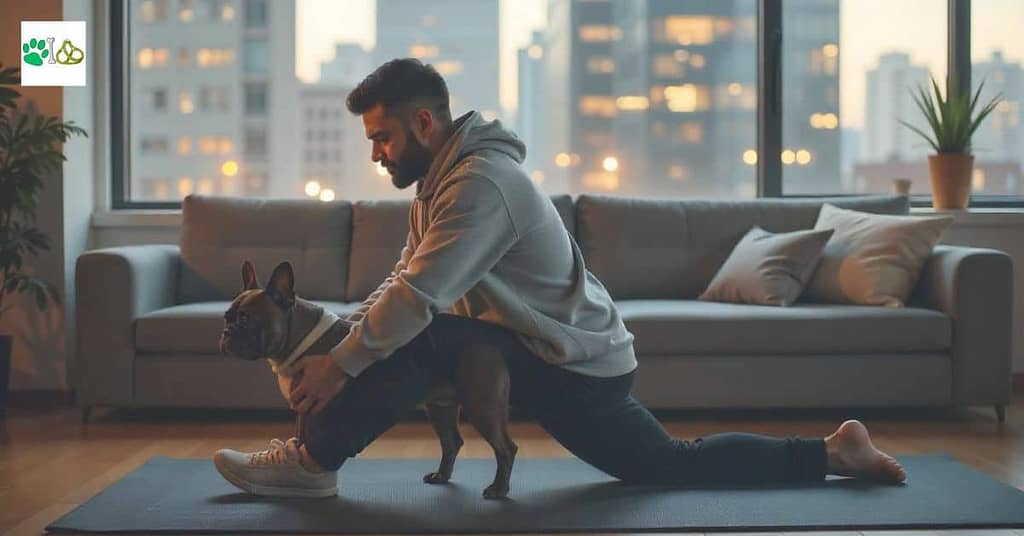Let’s face it- when your dog starts limping out of nowhere, panic sets in. Is it a sprain? Arthritis? Or worse, a torn ACL? In dogs, this injury isn’t technically an ACL (that’s a human term) but a cranial cruciate ligament (CCL) tear. Think of the CCL as your dog’s knee’s anchor rope; without it, every step feels like walking on a wobbly chair.
Lately, I’ve noticed more pet parents- from Sydney to Seattle- opting to skip surgery and try at-home recovery. Maybe it’s the cost (let’s be real, surgeries aren’t cheap), or maybe it’s the fear of putting their pup under anesthesia. But here’s the kicker: not all dogs can heal without surgery, and winging it without a vet’s guidance? That’s a recipe for disaster. This guide cuts through the noise to share what actually works, backed by vets and real-world success stories.

1. Understanding Dog ACL Injuries
The CCL: Your Dog’s Unsung Hero
Imagine your dog’s knee as a door hinge. The CCL is the screw holding that hinge together. When it snaps or frays, the door (aka their leg) can’t swing smoothly. Over time, this leads to arthritis, muscle loss, and that heartbreaking “hop” instead of a run.
How Do Dogs Tear Their CCL?
- Sudden moves: That wild squirrel chase in the backyard? Yep, a sharp turn can do it.
- Slow wear-and-tear: Older or overweight dogs often get “partial tears” from everyday strain.
- Breed quirks: Labs, Rotties, and Newfies are prone to weak ligaments genetically.
Spotting the Signs
Your dog might:
- Limp after playtime, but seems fine the next day (partial tear).
- Sit with their injured leg sticking out sideways.
- Whimper when you touch their knee.
How Vets Crack the Case
Your vet will do the drawer test– gently shifting the tibia forward like a drawer. If it moves too freely, that’s a red flag. They might also order X-rays to check for bone chips or arthritis.
2. When Is At-Home Recovery Appropriate?
Partial vs. Full Tears: The Make-or-Break Difference
- Partial tear: Think of a frayed rope. With rest, it might scar over and stabilize.
- Full tear: The rope’s snapped. Without surgery, the joint grinds bone-on-bone.
Who’s a Fit for Home Care?
- Small dogs (<25 lbs): Their lighter weight puts less strain on healing ligaments.
- Senior pups: If anesthesia is risky, conservative care buys comfort.
- Minor tears: No “drawer movement” during the vet exam? That’s a green light.
Surgery Is Non-Negotiable If…
- Your dog’s a 90-pound adventure buddy.
- The knee wobbles like Jell-O during the drawer test.
- They’re in constant pain, even after weeks of rest.
Golden Rule: Vet First, Google Later
I get it—Dr. Google is tempting. But misdiagnosing a CCL tear as a sprain can lead to permanent damage. Always start with a hands-on vet exam.
3. First Steps: Immediate Care After Diagnosis
Rest: The Boring (But Critical) Part
For the first 2 weeks, your dog’s life needs to rival a couch potato’s. No stairs, no zoomies, no jumping on beds. Use a leash indoors to prevent sneaky sprints to the food bowl.
Crafting a Safe Zone
- Flooring: Throw down yoga mats or rugs. Slippery floors = reinjury risk.
- Bedding: Memory foam > fluffy beds. It supports joints without sagging.
- Gates/playpens: Baby gates aren’t just for toddlers. Use them to block off stairs.
Ice Packs: Your New Best Friend
Wrap an ice pack in a dish towel and press it gently against the knee for 5-10 minutes, 3x/day.
Pro tip: Freeze a water-filled latex glove- it molds to the joint better!
4. Essential At-Home Recovery Strategies
Controlled Leash Walks: Slow and Steady Wins the Race
After 2–4 weeks of strict rest, your dog might act like they’ve won the lottery when the leash comes out. Don’t fall for it. Start with 5-minute “sniff walks” on flat ground, 2–3 times daily. Use a harness, not a collar, to avoid neck strain. If they pull or limp, cut the walk short.
Pro tip: Walk them after a massage or ice pack session when they’re calmer.
Physical Therapy: No Gym Membership Required
- Range of motion: Gently bend and extend your dog’s leg for 3–5 reps, 2x/day. Think of it as yoga for their knee.
- Weight shifting: Hold a treat near their hip to encourage leaning on the injured leg. Reward even a 2-second hold!
- Balance games: Place their front paws on a couch cushion (knee-height) and lure them upward with a treat.
Hydrotherapy on a Budget
No fancy underwater treadmills? No problem. Fill a kiddie pool with warm water (shoulder-height for your dog) and let them paddle for 5–10 minutes. The buoyancy takes pressure off the joint while building muscle. Always supervise– exit immediately if they panic or swallow water.
Massage & Chiropractic Care: Pampering With Purpose
- Massage: Use your thumb to make tiny circles around the knee for 2 minutes daily. Avoid pressing directly on swollen areas.
- Chiropractic: Seek a certified animal chiropractor. One client’s Dachshund went from dragging his legs to trotting after 3 sessions!
5. Supportive Devices and Natural Aids
Knee Braces: Helpful or Hype?
Pros: Can stabilize partial tears in small dogs (<30 lbs). Look for custom-fit braces with vet approval.
Cons: Often slip on furry legs. Bulldogs and other barrel-chested breeds? Forget it—they will chew it off.
Supplements That Actually Work
- Glucosamine/chondroitin: The OG joint duo. Studies show improvement in 6–8 weeks.
- Omega-3s: A teaspoon of fish oil daily cuts inflammation better than some meds.
- Turmeric & boswellia: Mix a pinch of turmeric paste (turmeric + coconut oil + black pepper) into meals.
Anti-Inflammatory Diet Hacks
Swap processed kibble for:
- Lean proteins: Ground turkey, eggs, or sardines.
- Veggies: Steamed sweet potatoes and green beans.
- Avoid: Wheat and corn- common inflammation triggers.
Cold Laser Therapy: Sci-Fi Healing at Home
Portable devices like the Theralase (200–400) use red light to speed cell repair. Treat the knee for 5 minutes daily. One user’s 12-year-old Beagle ditched her limp in 3 weeks!
6. Preventing Setbacks and Monitoring Progress
Is It Working? Look For These Signs
- Improving: Less morning stiffness, putting a light weight on the leg while peeing.
- Trouble: Swelling returns, or your dog starts “toe-touching” (paw barely grazing the ground).
The Art of Slow Progress
If there’s no limping, add 5 minutes to walks every 2 weeks. At 8 weeks, introduce gentle inclines. Still doing great? Let them trot (not run) for 10 seconds during walks.
When to Call the Vet (Again)
- Limping worsens after 10 days of home care.
- The knee feels warm or looks “puffy” compared to the other leg.
- Your dog stops eating or seems depressed.
The Golden Rule: No Jumping!
Block access to furniture with foam stairs (yes, even for Chihuahuas). One missed jump can undo months of healing.
7. Real Owner Stories & Expert Insights
Case Study: Bella’s 6-Month Journey Back to Playtime
Bella, a 35-pound Border Collie mix, tore her CCL during a game of fetch. Her owner, Sarah, opted for at-home recovery after their vet confirmed a partial tear.
Here’s how it unfolded:
- Weeks 1–4: Strict crate rest, ice packs, and anti-inflammatory supplements. “She hated it—we both did,” Sarah admits.
- Month 2: Leash walks began (5 minutes, 3x/day) + hydrotherapy in a kiddie pool.
- Month 3: Setback! Bella re-injured her knee jumping off the bed. She is back to rest for two weeks.
- Month 6: Gradual return to light hikes. “Now she’s slower but steadier,” Sarah says.
Vet Wisdom: Straight from the Experts
- Dr. Lisa Nguyen, DVM: “For small dogs with partial tears, home care can work—but only with a vet’s oversight. I’ve seen too many well-meaning owners rush the process.”
- Mia Carter, Canine Rehab Specialist: “Hydrotherapy isn’t just for post-surgery dogs. Even a bathtub session can rebuild muscle safely.”
See Also: Dog Halo for Blind Dogs: 2025’s Complete Guide to Safety, Training & Top Picks
8. FAQs on Dog ACL recovery at home
Q: Can a dog’s ACL heal without surgery?
A: Partial tears in small dogs often can, especially with strict rest and rehab. Full tears in active breeds? Surgery’s usually the only fix.
Q: How long does at-home recovery take?
A: Expect 3–6 months. Bella’s story isn’t unusual- it’s a marathon, not a sprint.
Q: What activities should I ban during recovery?
A: No jumping, stairs, or off-leash play. Even a 10-second zoomie can undo progress.
Q: Are there risks to skipping surgery?
A: Yes. Untreated tears often lead to arthritis or tears in the other knee (40% of dogs within a year!).
Conclusion
Healing a dog’s CCL tear at home isn’t easy, but it’s possible with:
- Early vet visits: Catch tears before they worsen.
- Discipline: No cheating on rest or leash rules.
- Patience: Celebrate tiny wins, like that first steady step.
But let’s be clear: This isn’t a DIY project. Always partner with your vet—they’ll spot red flags you might miss.
Final Note
Every dog heals differently. Take it from Bella, who now enjoys gentle trail walks, or Max, the senior Dachshund who thrives with weekly massages. Stay hopeful, stay consistent, and always keep your vet on speed dial.



